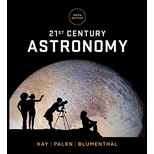
Concept explainers
Rank the least massive to most massive star.
Answer to Problem 1QP
The least massive to most massive star is black hole, neutron star, and white dwarf.
Explanation of Solution
The massive stars are formed within dense clouds of dust and gas located in the interstellar medium of a galaxy. Gravity causes these clouds to collapse in on them with small disturbance within a cloud causing denser clumps of matter.
If the surviving core is acts between 1.4 solar masses it contracts to become a tiny, very dense Neutron star.
The masses for both white dwarfs and neutron stars have an upper limit, dense stellar remnants more massive than about
Conclusion:
Therefore, the least massive to most massive star is block hole, neutron star, and white dwarf.
Want to see more full solutions like this?
Chapter 18 Solutions
21st Century Astronomy (fifth Edition)
- Hypernovae are thought to be a. a star greater than 20 solar masses collapsing into a black hole. b. binary systems involving mass transferred to a neutron star. c. binary systems involving mass transferred to a white dwarf. d. two main-sequence stars colliding. e. binary systems involving mass transferred to a black hole.arrow_forwardBlack holes are formed by A. collapsed dark nebulae. B. supernovae from binary stars. C. a lack of any light in a region of space. D. supernovae from the most massive stars.arrow_forwardThe density of a ________________ is greater than the density of a _________________. a. white dwarf; neutron star b. neutron star; black hole c. pulsar; neutron star d. pulsar; white dwarf e. white dwarf; black holearrow_forward
- Black hole candidates are conspicuous by their continuous or flickering emission of a. infrared light. b. ultraviolet light. c. gamma rays. d. X rays. e. all of the above.arrow_forwardThe orbit of the binary pulsar PSR 1936+16, studied by Taylor and Hulse, a. is so small that the orbital period is smaller than the pulsar period. b. is growing smaller, presumably by emitting gravitational waves. c. provides evidence that it is being orbited by at least 6 planets the size of Jupiter. d. shows large changes each time an X ray burst is emitted from the system. e. contains a white dwarf and a black hole.arrow_forwardIn order to form a black hole, a star must be about how much more massive than our Sun? a. Fifty times as massive b. Ten times as massive c. Twice as massive d. Twenty times as massive e. It actually must be less massive than our Sunarrow_forward
- Of the following objects, the one that produces the least energy is a a. supernova. b. Type 1 Seyfert galaxy. c. Type 2 Seyfert galaxy. d. quasar.arrow_forwardWhich of the following nuclear fuels does a one-solar-mass star use over the course of its entire evolution? a. hydrogen b. hydrogen and helium c. hydrogen, helium, and carbon d. hydrogen, helium, carbon, and neon e. hydrogen, helium, carbon, neon, and oxygenarrow_forwardPulsars result from a. expanding red giant stars b. white dwarf supernovas c. spinning neutron starsarrow_forward
- If a stellar remnant is in between 0.4 and 1.4 solar masses, the resulting object will be a a. brown dwarf. b. red dwarf. c. white dwarf. d. neutron star. e. black hole.arrow_forwardWhich of the following statements about novae is not true? A. A nova involves fusion taking place on the surface of a white dwarf. B. A star system that undergoes a nova may have another nova sometime in the future. C. Our Sun will probably undergo at least one nova when it becomes a white dwarf about 5 billion years from now. D. When a star system undergoes a nova, it brightens considerably, but not as much as a star system undergoing a supernova. Is the answer C? Since the sun has no companion star, it cannot gain accreted matter to initiate a nova and so it would not undergo a nova, it would just undergo a type I supernova? Thanks!arrow_forwardOnce carbon builds up in the Sun's core, astronomers expect our Sun to first become a red giant, then a .. Select one: A. neutron star B. red dwarf C. planetary nebula D. black hole E. pulsararrow_forward
 Foundations of Astronomy (MindTap Course List)PhysicsISBN:9781337399920Author:Michael A. Seeds, Dana BackmanPublisher:Cengage Learning
Foundations of Astronomy (MindTap Course List)PhysicsISBN:9781337399920Author:Michael A. Seeds, Dana BackmanPublisher:Cengage Learning Stars and Galaxies (MindTap Course List)PhysicsISBN:9781337399944Author:Michael A. SeedsPublisher:Cengage Learning
Stars and Galaxies (MindTap Course List)PhysicsISBN:9781337399944Author:Michael A. SeedsPublisher:Cengage Learning An Introduction to Physical SciencePhysicsISBN:9781305079137Author:James Shipman, Jerry D. Wilson, Charles A. Higgins, Omar TorresPublisher:Cengage Learning
An Introduction to Physical SciencePhysicsISBN:9781305079137Author:James Shipman, Jerry D. Wilson, Charles A. Higgins, Omar TorresPublisher:Cengage Learning Physics for Scientists and Engineers: Foundations...PhysicsISBN:9781133939146Author:Katz, Debora M.Publisher:Cengage Learning
Physics for Scientists and Engineers: Foundations...PhysicsISBN:9781133939146Author:Katz, Debora M.Publisher:Cengage Learning Physics for Scientists and EngineersPhysicsISBN:9781337553278Author:Raymond A. Serway, John W. JewettPublisher:Cengage Learning
Physics for Scientists and EngineersPhysicsISBN:9781337553278Author:Raymond A. Serway, John W. JewettPublisher:Cengage Learning Principles of Physics: A Calculus-Based TextPhysicsISBN:9781133104261Author:Raymond A. Serway, John W. JewettPublisher:Cengage Learning
Principles of Physics: A Calculus-Based TextPhysicsISBN:9781133104261Author:Raymond A. Serway, John W. JewettPublisher:Cengage Learning





